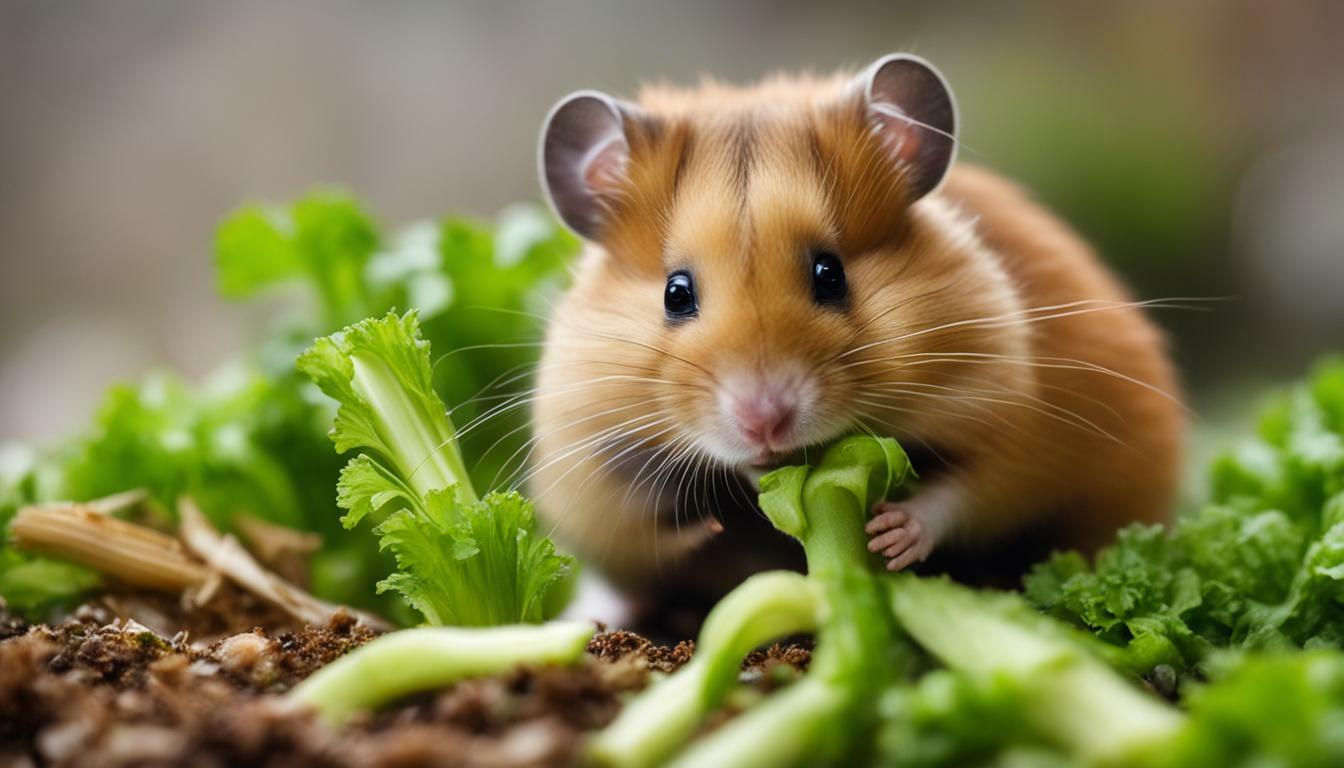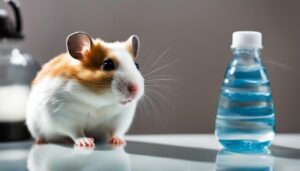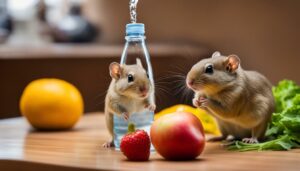If you’re wondering whether hamsters can eat celery, you’ve come to the right place. Celery can actually be a healthy addition to your hamster’s diet, but it’s important to feed it to them in moderation. This crunchy green vegetable offers a variety of nutritional benefits, making it a great snack option for your furry friend.
Key Takeaways:
- Celery is safe for hamsters to eat, but it should be given in small amounts.
- Celery is rich in vitamins A, B, C, E, and K, providing numerous health benefits.
- Feeding celery to hamsters can aid in digestion and help maintain dental health.
- When offering celery to your hamster, cut it into small pieces and remove any fibrous strands.
- Introduce new foods slowly to avoid stomach upset, and consider celery as an occasional treat.
While celery is a healthy option for hamsters, it’s important to remember that it should not replace their main diet. Your hamster’s diet should consist primarily of high-quality hamster pellets or food mixes specifically formulated for their nutritional needs. Treats like celery should be given sparingly and should not exceed 10% of their overall dietary intake.
In addition to celery, there are other safe vegetables that hamsters can enjoy. Leafy greens like spinach and kale, as well as vegetables such as broccoli, cauliflower, zucchini, and cucumber, can also be included in their diet. However, it’s important to avoid foods that can be harmful to hamsters, such as onions, garlic, chocolate, potatoes, avocado, almonds, apple seeds, and citrus fruits.
Remember to closely monitor your hamster’s health when introducing new foods and consult a veterinarian if you notice any adverse effects. Ultimately, the well-being of your hamster should be the top priority when deciding on their diet and treats.
Understanding Hamster Nutrition
Proper nutrition is vital for the health and well-being of your furry friend. Hamsters, like any other pets, require a balanced diet to thrive. When it comes to hamster nutrition, vegetables play a significant role. They provide essential vitamins, minerals, and fiber that contribute to your hamster’s overall health. Including a variety of vegetables in their diet can help prevent nutritional deficiencies and promote a strong immune system.
One important aspect of hamster nutrition is understanding which vegetables are safe for them to consume. While hamsters can enjoy a range of vegetables, some varieties are better suited than others. Leafy greens like spinach and kale are excellent choices as they are low in calories and high in nutrients. Other options include broccoli, cauliflower, zucchini, and cucumber. These vegetables offer a mix of vitamins and minerals that support your hamster’s well-being.
When introducing new foods to your hamster’s diet, it is crucial to do so gradually. Sudden changes in their diet can lead to digestive issues and upset stomachs. Start by offering small amounts of new vegetables and observe how your hamster reacts. If there are no adverse effects, you can gradually increase the portion size. It’s important to note that vegetables should complement their main diet and not replace it entirely. Commercial hamster food provides essential nutrients that cannot be obtained solely from vegetables. Therefore, it’s best to strike a balance between treats and their regular diet.
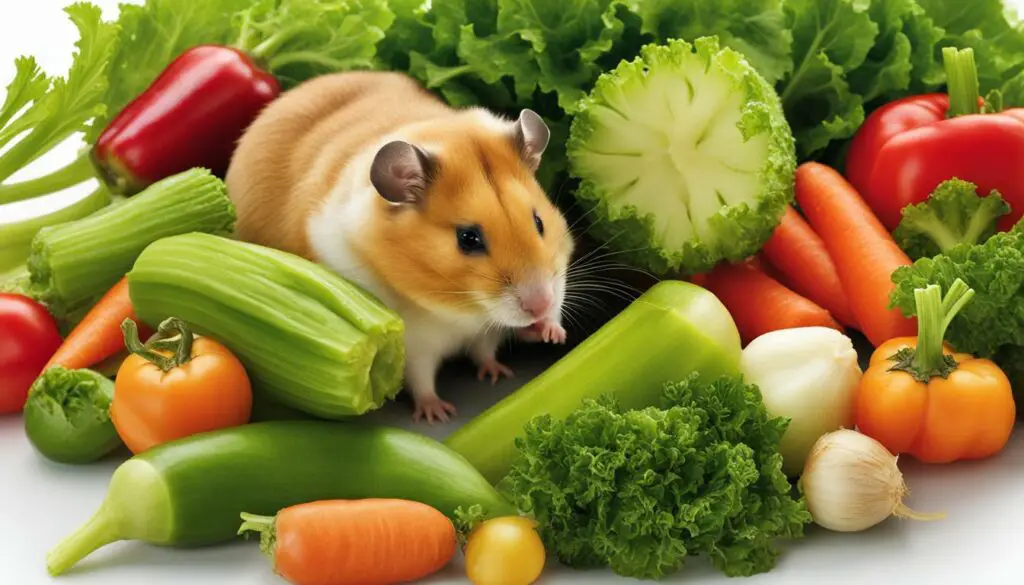
The Benefits of a Balanced Diet
A balanced diet plays a significant role in your hamster’s health. It improves their immune system, promotes healthy growth, and helps maintain a shiny and smooth coat. Additionally, a proper diet supports digestive health by providing sufficient fiber. Hamsters have a high metabolic rate, so their diet should consist of both proteins and carbohydrates. Commercial hamster food usually contains the right balance of nutrients, including grains, seeds, and pellets. Adding fresh vegetables to their diet supplements their nutritional needs and adds variety to their meals.
Conclusion
In conclusion, understanding hamster nutrition is essential for providing optimal care for your pet. Including vegetables in their diet is crucial for their overall health and well-being. Leafy greens, broccoli, cauliflower, zucchini, and cucumber are great options to consider. Remember to introduce new foods gradually and ensure they complement your hamster’s main diet. By providing a balanced diet and monitoring your hamster’s health, you can help them live a happy and healthy life.
| Safe Vegetables for Hamsters | Unsafe Foods for Hamsters |
|---|---|
|
|
The Health Benefits of Celery for Hamsters
Celery can offer a range of health benefits to your hamster when given in moderation. This crunchy vegetable is not only a tasty treat but also a nutritious addition to their diet. Celery contains essential vitamins and minerals that can support your hamster’s overall well-being.
One of the key benefits of celery is its high vitamin content. It is rich in vitamins A, B, C, E, and K, which are essential for maintaining a healthy immune system, promoting growth, and supporting proper organ function. These vitamins also have antioxidant properties, helping to protect your hamster’s cells from damage caused by free radicals.
Celery is also known for its anti-inflammatory properties, thanks to the presence of substances like apigenin and luteolin. These compounds can help reduce inflammation and support your hamster’s overall health. Additionally, celery’s high fiber content can aid in digestion and promote regular bowel movements.
When feeding celery to your hamster, it’s important to ensure they consume it in small, bite-sized pieces. Remove any fibrous strands to prevent choking. Some hamsters may not be too fond of celery leaves due to their strong taste, but you can still offer them as an option. Remember to introduce new foods gradually to avoid upsetting your hamster’s delicate digestive system, and always prioritize their health and well-being when incorporating fresh vegetables into their diet.
“Celery provides a nutritious and flavorful snack for your hamster. Its vitamins, antioxidants, and anti-inflammatory properties can contribute to their overall health.”
Other Safe Vegetables for Hamsters
In addition to celery, there are several other safe vegetables that hamsters can enjoy. Leafy greens like spinach and kale are excellent choices, as they are packed with vitamins and minerals. Broccoli and cauliflower provide a good mix of nutrients, while zucchini and cucumber offer hydration and a refreshing crunch.
When offering new vegetables, it is best to do so gradually and monitor your hamster’s response. Not all hamsters will have the same preferences, so it’s essential to observe their appetite and adjust accordingly. Remember, a varied and balanced diet is key to ensuring your hamster receives the necessary nutrients for optimal health.
| Safe Vegetables for Hamsters | Benefits |
|---|---|
| Spinach | High in iron and vitamins A, C, and K. |
| Kale | Rich in antioxidants, fiber, and vitamins A, C, and K. |
| Broccoli | Provides vitamins C and K and is a good source of fiber. |
| Cauliflower | Contains vitamins C and K, as well as fiber. |
| Zucchini | Provides hydration and is low in calories. |
| Cucumber | Hydrating and crunchy, a great summer snack. |
Remember to wash all vegetables thoroughly before serving them to your hamster, and always remove any uneaten portions from their enclosure to maintain cleanliness.
By offering a variety of safe vegetables, like celery and others mentioned above, you can enhance your hamster’s diet and provide them with a range of essential nutrients. However, it’s crucial to consult a veterinarian if you notice any adverse effects after introducing new foods. With proper care and a balanced diet, your hamster can thrive and enjoy a healthy, happy life.
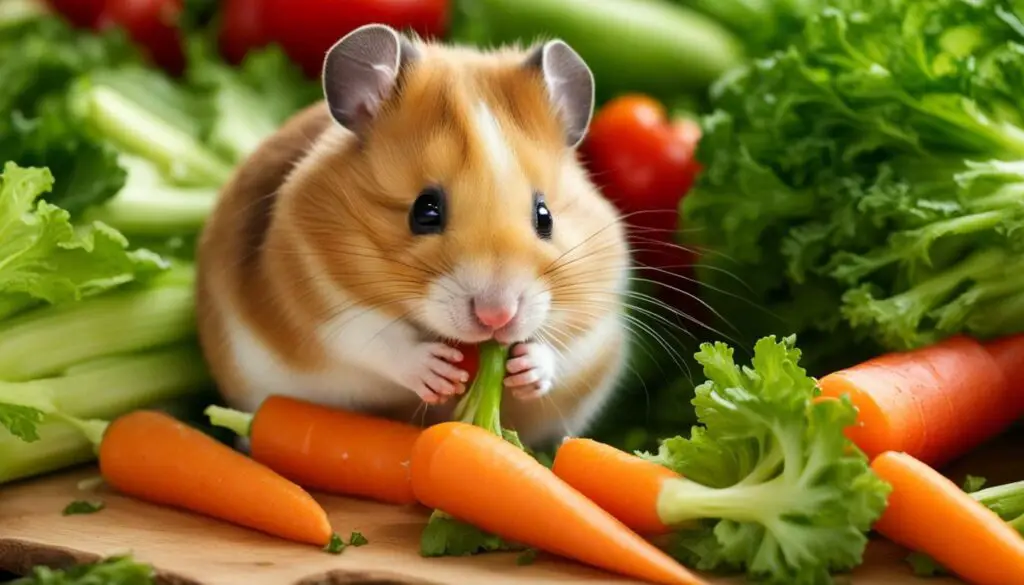
Before offering celery to your hamster, it’s important to know how to serve it safely. Celery can be a healthy and nutritious addition to their diet, but there are a few precautions to keep in mind.
First, you’ll want to wash the celery thoroughly to remove any dirt or pesticides. After washing, cut the stalks into small, bite-sized pieces. This will make it easier for your hamster to chew and digest. Additionally, remove any fibrous strands from the celery, as these can pose a choking hazard.
When introducing celery to your hamster, start with small amounts and observe their reaction. Some hamsters may enjoy celery right away, while others may need time to adjust to the taste and texture. If your hamster shows signs of stomach upset, such as diarrhea or loss of appetite, discontinue feeding celery and consult a veterinarian.
Remember, celery should be offered as an occasional treat and not a substitute for your hamster’s main diet. A balanced diet for hamsters includes a variety of fresh vegetables, along with a good quality hamster pellet or mix. To ensure optimal nutrition, consult a veterinarian or a knowledgeable pet store for specific dietary recommendations for your hamster.
| Safe Vegetables for Hamsters | |
|---|---|
| 1. Leafy greens (spinach, kale, romaine lettuce) | 6. Zucchini |
| 2. Broccoli | 7. Cucumber |
| 3. Cauliflower | |
| 4. Carrots | |
| 5. Bell peppers | |
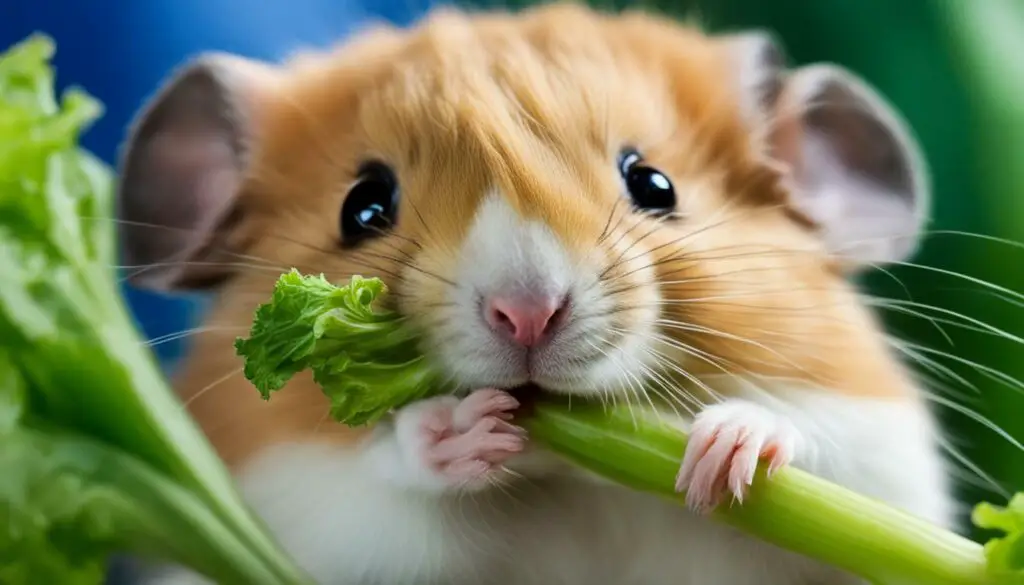
Quote:
“Offering a variety of fresh vegetables, including celery, can provide enrichment and promote a healthy diet for your hamster.” – Dr. Sarah Thompson, Small Animal Veterinarian
By following these guidelines, you can safely incorporate celery into your hamster’s diet and provide them with a nutritious snack. Remember to always prioritize your hamster’s health and consult a veterinarian if you have any concerns or questions about their diet.
Introducing New Foods to Your Hamster
When it comes to expanding your hamster’s diet, a gradual approach is key. You want to introduce new foods slowly to ensure that your furry friend’s stomach doesn’t get upset. It’s important to remember that hamsters have sensitive digestive systems, and sudden changes in their diet can lead to gastrointestinal issues.
One safe and nutritious option to consider is celery. Celery is packed with vitamins A, B, C, E, and K, making it a healthy snack for your hamster. It also provides antioxidant and anti-inflammatory support, aiding your pet’s overall well-being. Additionally, celery can help with digestion and dental health, as it helps file down overgrowing teeth.
When offering celery to your hamster, remember to cut the stalks into small, manageable pieces. This will prevent choking and make it easier for your hamster to consume. Removing the fibrous strands from the celery stalks is also recommended. While you can offer the leaves of celery to your hamster, they may not be as interested in them due to their strong taste.
| Safe Vegetables for Hamsters | |
|---|---|
| Spinach | Broccoli |
| Kale | Cauliflower |
| Zucchini | Cucumber |
In addition to celery, there are other vegetables that you can introduce to your hamster’s diet. Leafy greens like spinach and kale, broccoli, cauliflower, zucchini, and cucumber are all safe options. These vegetables provide a variety of nutrients and can help keep your hamster healthy and happy.
However, there are certain foods that you should avoid giving to your hamster. Onions, garlic, chocolate, potatoes, avocado, almonds, apple seeds, and citrus fruits can be toxic to these small pets. It’s always best to err on the side of caution and consult a veterinarian if you’re unsure about a specific food’s safety for your hamster.
Remember, the health and well-being of your hamster should always be your top priority. While fresh vegetables like celery can be a great addition to their diet, they should be offered in moderation and as a treat rather than a substitute for their main diet. Keep an eye on your hamster’s overall health and behavior, and consult a professional if you notice any adverse effects after introducing new foods.
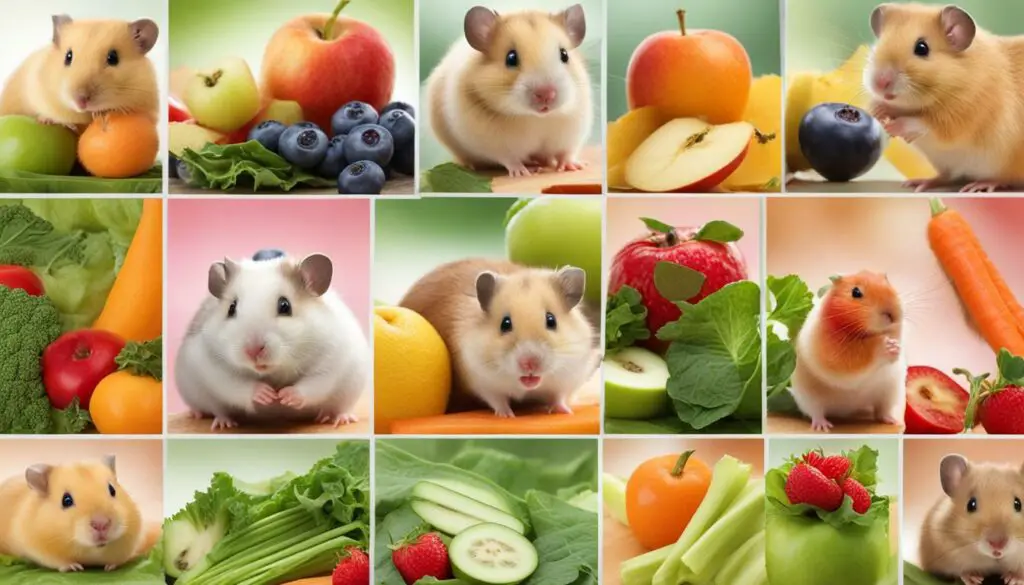
In addition to celery, there are several other vegetables that your hamster can safely consume. These vegetables not only provide essential nutrients but also add variety to your hamster’s diet. It’s important to remember that hamsters have sensitive digestive systems, so introducing new foods gradually is crucial to prevent any digestive issues.
Leafy greens such as spinach and kale are excellent options for your hamster. These vegetables are rich in vitamins and minerals, including vitamin A and calcium. Just like with celery, make sure to wash the greens thoroughly and remove any tough stems. You can offer them in small pieces for your hamster to enjoy.
Another great vegetable for hamsters is broccoli. Broccoli is packed with fiber, vitamin C, and antioxidants. Remember to cut the broccoli into small, bite-sized pieces to make it easier for your hamster to eat and digest.
| Safe Vegetables for Hamsters | Benefits |
|---|---|
| Spinach | Rich in vitamins A and C, as well as calcium |
| Kale | High in vitamin A and calcium |
| Broccoli | Excellent source of fiber, vitamin C, and antioxidants |
Other vegetables that you can include in your hamster’s diet are cauliflower, zucchini, and cucumber. These vegetables are low in calories but still provide important vitamins and minerals. Just like with any new food, introduce them slowly and monitor your hamster for any adverse reactions.
Remember, while it’s important to offer your hamster a varied diet, the main portion of their nutrition should come from a balanced hamster food mix specifically formulated for their needs. Fresh vegetables should be given as occasional treats to supplement their diet and provide enrichment. By offering a variety of safe vegetables, you can ensure that your hamster stays healthy and happy.
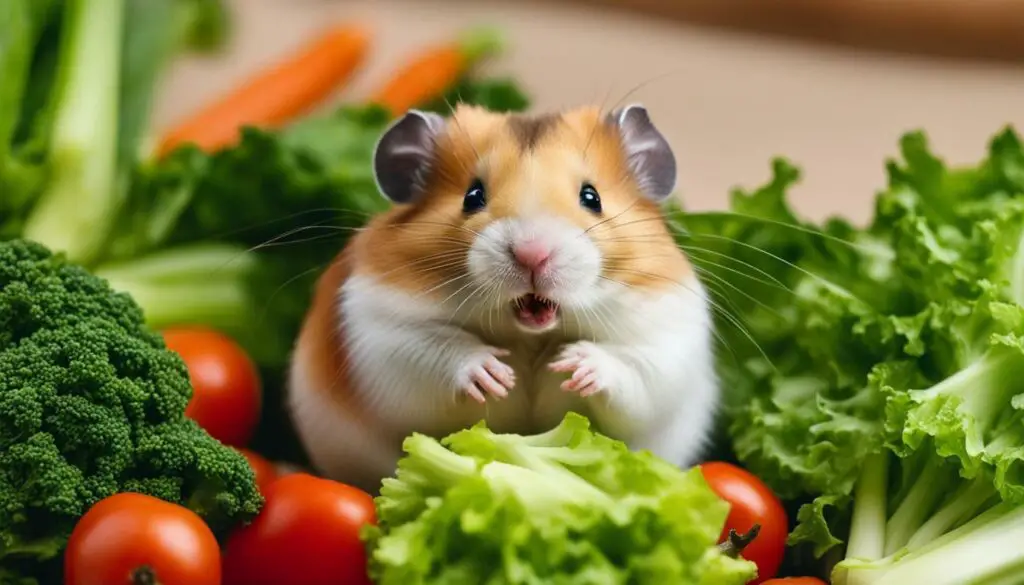
While there are many safe options, there are also foods that hamsters should never eat. As a responsible hamster owner, it is important to be aware of these foods to ensure the health and well-being of your furry friend. Some foods can be toxic, cause digestive issues, or even be potentially fatal for hamsters. To keep your hamster safe, here is a list of foods that should be avoided in their diet:
| Foods to Avoid | Reason |
|---|---|
| Onions and Garlic | These foods can cause digestive upset and even damage the red blood cells in hamsters. |
| Chocolate | Chocolate contains theobromine, which is toxic to hamsters and can lead to seizures, heart problems, and even death. |
| Potatoes | Raw potatoes and potato sprouts contain solanine, a toxic substance for hamsters that can cause severe gastrointestinal issues. |
| Avocado | Avocado contains a substance called persin, which is toxic to hamsters and can cause breathing difficulties, fluid accumulation in the chest, and even death. |
| Almonds | Almonds are high in fat and can lead to weight gain and digestive issues in hamsters. |
| Apple Seeds | Apple seeds contain cyanide, a toxic substance that can be harmful to hamsters if ingested in large quantities. |
| Citrus Fruits | Fruits like oranges, lemons, and grapefruits are too acidic for hamsters and can cause digestive upset. |
It is essential to remember that hamsters have sensitive digestive systems, and even small amounts of these foods can have severe consequences. If your hamster accidentally ingests any of these foods, it is crucial to seek immediate veterinary attention.
By being aware of these foods to avoid and providing a balanced diet with safe options, you can ensure the optimal health and happiness of your beloved hamster companion.
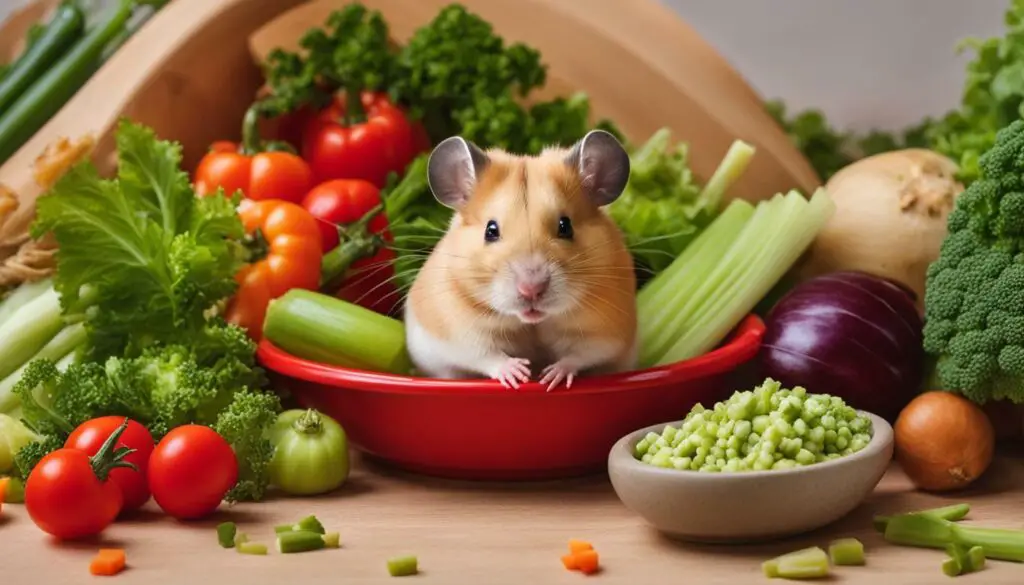
Disclaimer: The information provided in this article is for educational purposes only and should not replace veterinary advice. If you have any concerns or questions about your hamster’s diet, please consult with a veterinarian.
Monitoring Your Hamster’s Health
Your hamster’s well-being should always be a priority, and regular health monitoring is crucial. By paying attention to their overall behavior, appearance, and eating habits, you can ensure that your furry friend stays happy and healthy. Here are some key areas to focus on when monitoring your hamster’s health:
- Physical Appearance: Take note of any changes in your hamster’s fur, skin, or body size. A healthy hamster should have a shiny coat, clear eyes, and clean ears. If you notice any bald patches, redness, discharge, or lumps, it is important to consult a veterinarian.
- Activity Level: Observe your hamster’s energy levels and daily activities. They should be active, curious, and engaged in their environment. A sudden decrease in activity or lethargy may be a sign of illness.
- Eating and Drinking: Pay attention to your hamster’s appetite and water consumption. Any significant changes, such as a loss of appetite or excessive thirst, should be investigated further.
- Bowel Movements: Regular and formed feces are a good indication of a healthy digestive system. If you notice diarrhea, constipation, or irregular bowel movements, it may be a cause for concern.
It is important to note that hamsters are skilled at hiding their illnesses, so even subtle changes may be significant. If you have any doubts or concerns about your hamster’s health, it is always best to seek professional advice from a veterinarian who specializes in small animals.
Table: Common Health Issues in Hamsters
| Health Issue | Symptoms | Treatment |
|---|---|---|
| Respiratory Infections | Sneezing, coughing, labored breathing | Antibiotics prescribed by a veterinarian |
| Wet Tail | Diarrhea, lethargy, hunched posture | Fluid replacement therapy and medication |
| Dental Issues | Chewing difficulties, weight loss | Trimming of overgrown teeth, appropriate diet |
| Tumor | Lumps or growths on the body | Surgical removal by a veterinarian |
Remember, early detection and prompt treatment are key to preventing further complications and ensuring the well-being of your hamster. Keep an eye out for any signs of illness, provide a balanced diet, and create a comfortable and clean living environment for your furry friend.
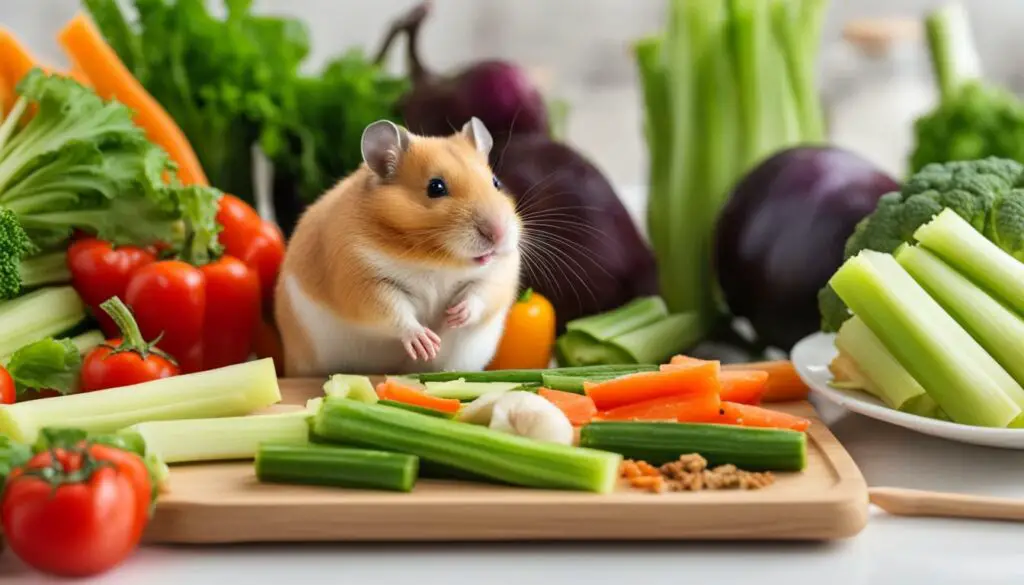
While treats like celery can be enjoyed by your hamster, it’s essential to maintain a balanced diet. Hamsters have specific dietary requirements that need to be met to ensure their overall health and well-being. Treats should only make up a small portion of their diet and should not replace their main food source.
The table below provides a handy guideline for balancing treats and main diet:
| Treats | Main Diet |
|---|---|
| Occasional | Regular |
| Celery | Hamster pellets |
| Leafy greens | Hamster mix |
| Broccoli | Fresh water |
Providing a balanced diet for your hamster is crucial to ensure they receive all the necessary nutrients. Their main diet should consist of hamster pellets or a hamster mix, which are specifically formulated to meet their nutritional needs. These pellets or mixes usually contain a combination of grains, seeds, and dried fruits and vegetables.
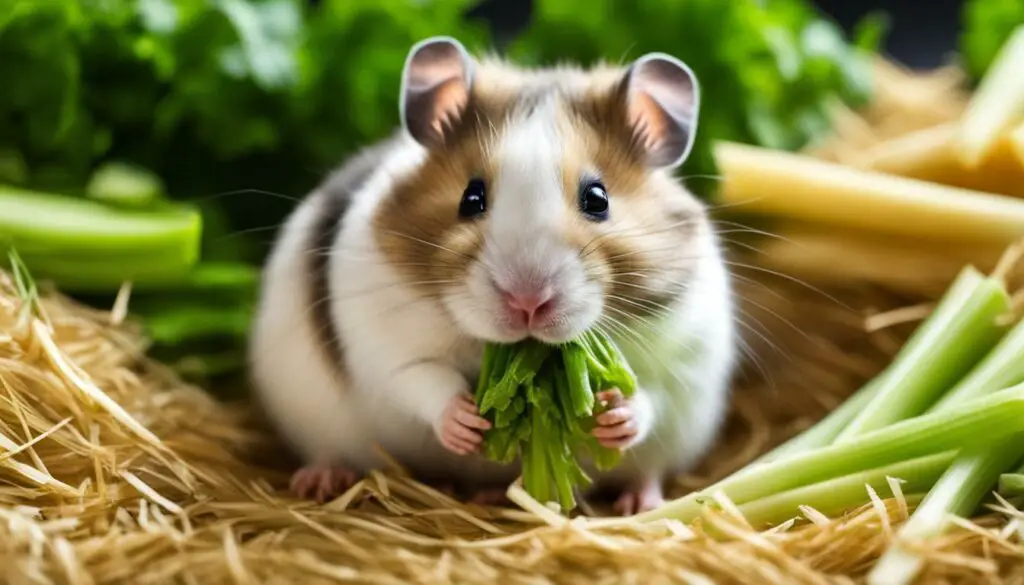
In addition to their main diet, treats like celery, leafy greens, and broccoli can be offered as occasional snacks. These treats provide additional nutrients and variety to their diet. However, it’s important to remember that treats should not exceed 10% of their overall food intake.
By maintaining a balanced diet for your hamster and offering treats in moderation, you can ensure their nutritional needs are met while still providing them with enjoyable and healthy snacks.
Conclusion
In conclusion, celery can be a healthy and nutritious snack for your hamster when given in moderation. This crunchy vegetable is packed with vitamins A, B, C, E, and K, providing essential nutrients to support your hamster’s overall health. Celery also offers antioxidant and anti-inflammatory properties, promoting a strong immune system and protecting against oxidative stress.
Aside from its nutritional benefits, celery plays a vital role in your hamster’s dental health. Gnawing on celery stalks helps file down their continuously growing teeth, preventing dental issues and keeping their pearly whites in check.
When offering celery to your hamster, it’s important to take some precautions. Cut the stalks into small, manageable pieces to avoid choking hazards, and remove any tough fibers that may be difficult for your furry friend to digest. While the leaves of celery can also be offered, some hamsters may find their flavor too strong and may not eat them.
| Foods Safe for Hamsters | Foods to Avoid for Hamsters |
|---|---|
|
|
Remember to introduce new foods gradually to your hamster’s diet, as sudden changes can lead to stomach upset. Celery should be given as an occasional treat rather than a main component of their diet. If you notice any adverse effects after introducing new foods, it is recommended to consult a veterinarian for guidance and support.
Your hamster’s health and well-being should always be your top priority when considering their diet. By providing a balanced and varied diet, including nutritious snacks like celery, you can ensure your furry friend lives a happy and healthy life.
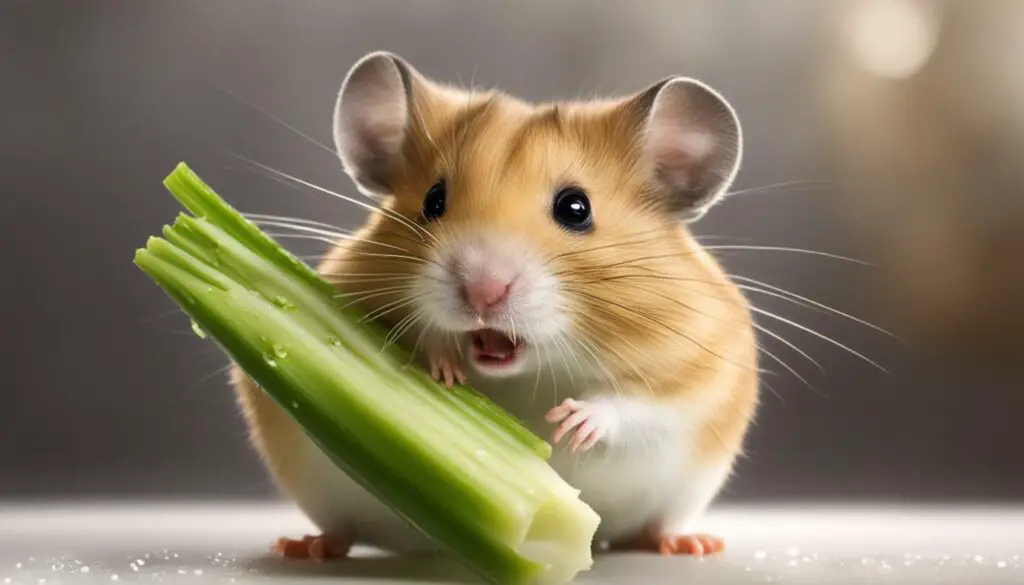
In conclusion, celery can be a healthy and nutritious snack for your hamster when given in moderation. It contains a range of vitamins and provides antioxidant and anti-inflammatory support, benefiting your pet’s overall health. Additionally, the crunchy texture of celery helps to file down overgrowing teeth, promoting dental health.
When feeding celery to your hamster, it is important to cut the stalks into small pieces and remove any fibrous parts to prevent choking. Although the leaves of celery can also be offered, some hamsters may not enjoy their strong taste. Remember to introduce new foods gradually to avoid stomach upset, and keep in mind that celery should be an occasional treat rather than a substitute for their main diet.
While celery is a safe vegetable for hamsters, there are certain foods that should be avoided. These include onions, garlic, chocolate, potatoes, avocado, almonds, apple seeds, and citrus fruits, as they can be toxic to hamsters. If you notice any adverse effects after introducing new foods to your hamster’s diet, it is recommended to consult a veterinarian for further guidance and advice.
Ultimately, when feeding your hamster fresh vegetables, it is crucial to prioritize their health and well-being. By providing a balanced diet, including safe vegetables like celery, you can ensure your furry friend stays happy and healthy for years to come.
FAQ
Can hamsters safely eat celery?
Yes, hamsters can safely eat celery, but it should be given to them in moderation.
Why is celery a healthy snack for hamsters?
Celery contains vitamins A, B, C, E, and K, and provides antioxidant and anti-inflammatory support. It also aids in digestion and helps maintain dental health.
How should celery be prepared for hamsters?
The stalks should be cut into small pieces and the fibers removed to prevent choking. The leaves of celery can also be offered, although hamsters may reject them due to their strong taste.
What are some other safe vegetables for hamsters?
Other vegetables that hamsters can eat include leafy greens like spinach and kale, broccoli, cauliflower, zucchini, and cucumber.
What foods should hamsters avoid?
Hamsters should not be given foods such as onions, garlic, chocolate, potatoes, avocado, almonds, apple seeds, and citrus fruits, as these can be toxic to them.
What should I do if my hamster has an adverse reaction to a new food?
It is recommended to consult a veterinarian if any adverse effects occur after introducing new foods to a hamster’s diet.
How should treats be incorporated into a hamster’s diet?
Treats should be balanced and given as occasional additions to a hamster’s main diet.

